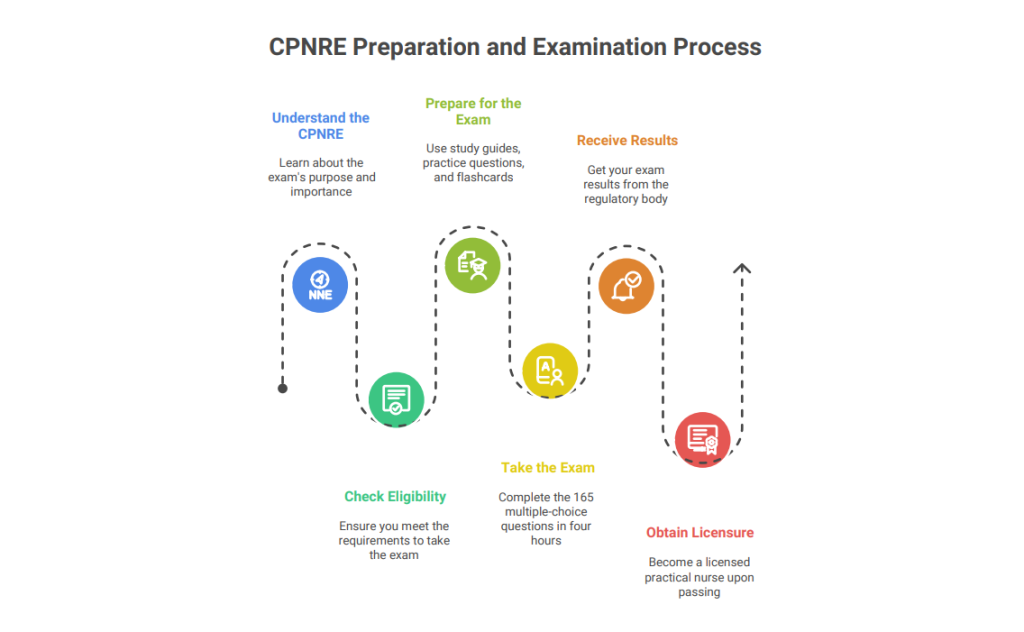Preparing to become a practical nurse in Canada means one crucial milestone: successfully writing the Canadian Practical Nurse Registration Examination (CPNRE). This guide is designed to help you understand the exam, build confidence with effective CPNRE prep strategies, and leverage tools like flashcards and online resources. Whether you are just starting your preparation or polishing your exam-day techniques, this article provides a detailed roadmap to improve your chances of passing the CPNRE.
- What Is the CPNRE and Why Does It Matter?
- Who Is Eligible to Write the CPNRE?
- What Is the Format of the CPNRE Examination?
- How Should Practical Nurses Prepare for the CPNRE?
- Why Is a CPNRE Prep Guide Essential?
- What Role Do Practice Exams and Practice Questions Play?
- How to Use Flashcards and Quizlet for CPNRE Practice?
- What Nursing Scenarios Should You Expect on Exam Day?
- How to Apply Practice Time Management During the Exam?
- What Happens After You Take the CPNRE?
- FAQs on the CPNRE
- Conclusion
What Is the CPNRE and Why Does It Matter?
The CPNRE is the registration exam for those aiming to become a practical nurse in Canada. Officially known as the Canadian Practical Nurse Registration Examination, it assesses whether a candidate has the knowledge, judgment, and skill to deliver safe and effective nursing care.
Successfully passing the CPNRE is a legal requirement to practice. It doesn’t just test your memorization but evaluates your ability to apply nursing knowledge, interpret physician orders, create a nursing care plan, and respond appropriately in areas like long-term care facilities or acute settings. The exam ultimately asks the practical nurse to prove readiness for real-world healthcare challenges.
Who Is Eligible to Write the CPNRE?
To be eligible to write the CPNRE, candidates must complete an approved practical nursing program in Canada. International applicants may also qualify if their education and experience meet provincial or territorial requirements.
Upon graduation, most nursing regulatory bodies issue a practice permit, which allows candidates to work temporarily while preparing for the actual exam. This ensures that practical nurses can begin contributing to healthcare teams even before receiving official results.
What Is the Format of the CPNRE Examination?
The exam format is standardized across provinces. The actual CPNRE consists of 165 multiple-choice questions, which must be completed within four hours. Each question is designed to reflect real-life nursing practice, often involving patient scenarios and critical decision-making.
The exam includes questions on vital signs, medication management (such as type 2 diabetes or type 1 diabetes mellitus care), and conditions like chronic obstructive pulmonary disease. It also assesses knowledge across diverse areas of practical nursing, including health promotion, long-term care, and acute care environments.
How Should Practical Nurses Prepare for the CPNRE?
To prepare for the CPNRE, candidates should combine theory review with applied practice. Reading textbooks is not enough; you must practice answering questions under exam conditions.
Many candidates find it helpful to review information about the CPNRE published by their regulatory body. These official guidelines provide insight into what to expect on exam day, helping you prepare for the examination with greater confidence.

Why Is a CPNRE Prep Guide Essential?
A structured CPNRE prep guide ensures that your preparation covers all required topics. Without a plan, it’s easy to spend too much time on certain areas and neglect others.
Good guides emphasize the exam’s blueprint and include a balanced mix of theory, practice questions, and strategies for practice time management. They also highlight how to take the CPNRE effectively—understanding the pacing, question structure, and critical thinking skills needed.
What Role Do Practice Exams and Practice Questions Play?
Taking a CPNRE practice exam is one of the most effective preparation strategies. Simulating the actual exam helps you identify weaknesses, build confidence, and improve speed. Working through CPNRE practice questions not only tests your knowledge but also teaches you how to apply nursing interventions to patient cases.
For example, a practice test may ask how to respond when a patient’s vital signs indicate deterioration, or when providing care in a long-term care setting. In nursing exam prep, it is also useful to recognize how practice tests differ from predictor tests in terms of purpose and outcomes.
How to Use Flashcards and Quizlet for CPNRE Practice?
Flashcards are excellent tools for quick recall of key terms, definitions, and conditions. Many nursing students create cards for vital signs ranges, common medications, and steps in a nursing care plan.
Platforms like Quizlet allow practical nurses to access shared decks tailored to the CPNRE examination. Combining flashcards with online practice resources ensures well-rounded preparation and keeps information fresh before exam day.
What Nursing Scenarios Should You Expect on Exam Day?
The exam often asks the practical nurse to choose the best action in real-world cases. For example, you may be presented with a patient experiencing unstable blood sugar due to type 1 diabetes mellitus, or an elderly resident in a long-term care facility with declining vital signs.
Scenarios may also test your ability to evaluate physician orders, prioritize interventions, or manage complex cases like chronic obstructive pulmonary disease. These situations reflect daily nursing challenges, ensuring the exam aligns with professional expectations.
How to Apply Practice Time Management During the Exam?
Practicing time control is crucial, since candidates must complete 165 multiple-choice questions in four hours. Developing practice time management strategies during prep courses or while using online practice exams will help you avoid rushing at the end.
One recommended technique is to move past difficult questions and return later. This allows you to maximize correct responses on questions you can confidently answer while leaving time to revisit challenging ones.
What Happens After You Take the CPNRE?
After you write the CPNRE, your exam results are typically available within weeks. Results are delivered through your provincial regulatory body. Passing officially grants you licensure as a practical nurse in Canada, allowing you to begin full-time work.
Some candidates may receive feedback reports highlighting strengths and weaknesses. For those who do not pass, the predictor test is a tool that can help refine preparation for the next attempt. With persistence and proper support, successfully passing the CPNRE is achievable.
FAQs on the CPNRE
1. How hard is the CPNRE?
The CPNRE is a challenging exam because it doesn’t just test memory—it evaluates critical thinking and decision-making in real nursing scenarios. Questions require you to interpret vital signs, analyze physician orders, and decide on the safest nursing intervention. With consistent practice and a solid prep guide, most students find it manageable.
2. How many times can I attempt the CPNRE?
Most regulatory bodies allow up to three attempts, but this can vary by province. If you don’t succeed, you may need to complete additional prep courses or remedial study before retaking the registration exam. Always check the policies of your provincial nursing college.
3. How long should I study for the CPNRE?
Most nursing graduates spend 6–12 weeks preparing. Your timeline should depend on how recently you completed your practical nursing program and how comfortable you are with topics like type 1 diabetes mellitus, chronic obstructive pulmonary disease, or care in a long-term care facility. Daily review, combined with CPNRE practice questions and at least one full practice exam, is recommended.
4. What topics are covered on the exam?
The CPNRE examination covers a broad range of areas of practical nursing, including health promotion, medication administration, chronic illness care, acute interventions, and ethical practice. Expect case-based questions requiring safe decision-making, often in the context of patient-centered care.
5. Are there official CPNRE practice exams?
Yes. Regulatory bodies or authorized vendors often provide official CPNRE practice exams. These are valuable because they mimic the actual CPNRE in structure and difficulty. Many students also supplement with third-party online practice resources, Quizlet sets, and flashcards.
6. What should I expect on exam day?
On exam day, you’ll have four hours to complete 165 multiple-choice questions. Bring a government ID and follow the rules provided by the testing center. Expect scenario-based questions that reflect the daily work of a practical nurse in Canada.
Conclusion
The Canadian Practical Nurse Registration Examination (CPNRE) is the gateway to your career as a practical nurse in Canada. It challenges you to demonstrate both knowledge and judgment in patient-centered care, covering everything from long-term care to acute conditions like type 2 diabetes and chronic obstructive pulmonary disease.
Success requires more than memorization, it demands thoughtful preparation. By following a structured CPNRE prep guide, using practice questions, leveraging tools like Quizlet and flashcards, and completing at least one CPNRE practice exam, you will develop the confidence and competence needed to perform well.
Remember, the exam is not just about testing you, it is about ensuring you are ready to deliver safe, effective care in real-world settings. With dedication, smart strategies, and the right resources, you will be well on your way to successfully passing the CPNRE and beginning your rewarding journey as a licensed practical nurse.

